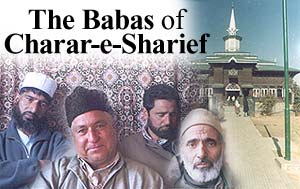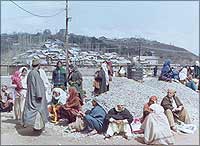The Rediff Special/ Josy Joseph

Six years ago, the Charar-e-Sharief -- till then a symbol of amity -- became another insurmountable barrier in the yawning divide between Kashmir and the rest of India. Matters were not helped much by the fact that the fire -- which began during a face-off between Indian security forces and militants holed up in the shrine -- happened during the holy Muslim festival of Id-ul-Zuha.
Today, the 14th century shrine to Sheikh Nooruddin Wali (Kashmir's patron saint revered by Muslims, Hindus and Sikhs) is, for the fifth time, preparing to grace the Valley's landscape. This time, though, it is happening under the watchful eye of Indian security forces. When completed, the new structure will be double its earlier size. Its old-world charm, though, may be lost forever. For, unlike its earlier wooden avatars, the present concrete walls and modern design no longer reflect the elegance of the past.
But then, in a town that still echoes the stifled wails of thousands of homeless people, will the Charar-e-Sharief ever be able to regain its lost glory? The Charar-e-Sharief was once a celebration of religious harmony. Then, anyone could have walked into any home here and stayed over, sharing meals and stories.
That changed forever in the conflagration of May 10-11, 1995. The next morning, when the Indian Army reached the shrine complex, everything, including the historic Khankah mosque, was in ashes. The militants, led by the dreaded Mast Gul, had already escaped.
Kashmir went into mourning.
 The then prime minister, P V Narasimha Rao, promised the Centre would help rebuild the shrine. But, says Ghulam Nabi Kochak, vice-chairman of the Muslim Aukuf Trust (which looks after the shrine), they don't know if the central government has given any kind of financial help. "We got Rs 2 crores from the state government. The rest of the money came from public donations." Other donors include the MAT itself and administrators of all the Muslims shrines in the Valley.
The then prime minister, P V Narasimha Rao, promised the Centre would help rebuild the shrine. But, says Ghulam Nabi Kochak, vice-chairman of the Muslim Aukuf Trust (which looks after the shrine), they don't know if the central government has given any kind of financial help. "We got Rs 2 crores from the state government. The rest of the money came from public donations." Other donors include the MAT itself and administrators of all the Muslims shrines in the Valley.
"We are rebuilding the shrine around the tomb, which survived the fire. Our architect, Muneer Ahmed Khan, created the new design after visiting Baghdad and other foreign cities." But, even before the construction began, there was a dispute about the new design between the Aukuf and the Charar-e-Sharief residents, who felt the construction should replicate the old design. Finally, they compromised on the present model.
This is the fifth time the Charar-e-Sharief is being rebuilt. Unlike the wooden structures of the past, the new shrine is mainly concrete. The inner walls, though, will be decorated with walnut-wood panels and, by the time it is thrown open to the public in mid-June, it will have a fire-resistant coat of paint. The narrow tower above the main structure will be carved out of deodhar (the most expensive wood in the Valley) and its top will be plated with gold.
"We cleaned out the premises within a month," recalls Ghulam Mohiuddin Baba, the local Aukuf administrator. "The construction began within six, seven months, as soon as the new model was ready." The new shrine's ground area, at 10,000 square feet, is double that of the old structure and has two floors inside for seating the devotees.
The general approach to the reconstruction, though, seems to be half-hearted. A few panels are already showing cracks, but the Aukuf authorities insist they will be replaced. "When it is handed over to us, the walls will be perfect," asserts Kochak. Not everyone agrees with him. Haji Mohammed Yusuf Baba Fateh Khan, a local Baba who chose to remain behind at Charar-e-Sharief, says, "Nobody is sincere. People seem to want to exploit even the construction of the shrine."
The Aukuf authorities say the project will cost approximately Rs 17 crores -- Rs 5 crores for the shrine, Rs 7 crores for the mosque and the rest for developing the exteriors, lawns, rest rooms, etc. "For the mosque, we will not deviate from the original design," says Kochak. "Its construction will begin once the shrine is ready." The decision has come under much criticism, since it will now take another four years for the mosque to be ready. "It should have been constructed first," says a displaced Charar-e-Sharief resident. "But they built the shrine first because that is where all the donations come."
Everyone agrees, though, that the fire has, in some ways, been a blessing in disguise. "The number of devotees have increased tremendously," says Mohiuddin Baba. Before the fire, the collection had never crossed Rs 20,00,000. Last year, say Aukuf authorities, it touched Rs 42,00,000. At present, they estimate over 50,000 people visit the shrine on Fridays, the most important week day. But the decade-long militancy has served to strip the crowd of its secular composition; the post-fire devotees are mainly Muslims.
The fire also destroyed the lives of hundreds of Babas, a community believed to be as old as the Charar-e-Sharief. Legend has it that they were once beggars at the shrine; today, they are mainly local Muslims lived in the area before 1995. Their homes were open lodges for all devotees; anyone was welcome to take shelter there and share their meals. "In return, a nominal payment would made to the family," says Baba Fateh Khan, who says he lost two of his three buildings in the fire.
 When the Baba families moved out, Charar-e-Sharief lost its centuries-old tradition of warm hospitality. "Now, people don't stay over for days as they used to. Once, the Charar-e-Sharief was like the Ajmer-e-Sharief and the average pilgrim would stay over for at least a day. Come rain, snow or heat, devotees would throng the shrine," says Baba Fateh Khan. Now, they only stay over on Thursdays, visit the shrine in the evening, attend the night-long prayers and leave on Friday. "We came early today morning," says a family who came from downtown Srinagar, "and will leave by evening."
When the Baba families moved out, Charar-e-Sharief lost its centuries-old tradition of warm hospitality. "Now, people don't stay over for days as they used to. Once, the Charar-e-Sharief was like the Ajmer-e-Sharief and the average pilgrim would stay over for at least a day. Come rain, snow or heat, devotees would throng the shrine," says Baba Fateh Khan. Now, they only stay over on Thursdays, visit the shrine in the evening, attend the night-long prayers and leave on Friday. "We came early today morning," says a family who came from downtown Srinagar, "and will leave by evening."
As a result, the Baba families have lost their source of income. "The militants led to all this. They were bad," admits Mohiuddin Baba. In the winter of 1994, the Babas were forced to accommodate them and were, as a result, harassed by the security agencies. "Yes," admitted one, "we have served food to the militants, they used to come to our homes. But you think we were happy about that? When the Indian Army could not do anything, what did you expect us to do?"
By February 1995, the siege had become a stand-off between the Indian security forces and militants. The Indian Army took up positions around Charar-e-Sharief, occupied most of the tall hills in the vicinity and began to carry out psychological warfare. Army helicopters would fly over the town, dropping leaflets that advised the locals to avoid physical contact with the militants who, they said, could be HIV-infected. "It was sometimes humiliating, mostly sad, but always frightening," recalls another Baba.
Still, life went on. Until, between May 8-11, 1995, a thousand homes went up in flames. The struggle to resettle themselves in new colonies, with new neighbours and new roads has been painful and, for the older residents in particular, rather stressful. Even though the new town is just four kilometres away from the shrine by road.
After the fire, the government announced a relief and resettlement package for the Babas. "But some of us are yet to receive our complete compensation," says Ghulam Razool Baba, a fireman who moved the J&K high court along with other affected people. The court ruled in their favour, but the litigants claim the order has yet not been implemented.
The government has fixed compensation as one plot for every structure destroyed. But, says Razool Baba, some multi-storeyed buildings housed two or three families. "So," he says, "in some cases, two or three families received only one plot." The government also gave the affected families Rs 200,000 per structure. "Again, where more than one family lived in a structure, the compensation had to be divided." He says his family owned three structures. "But the government counted them as one. Our appeal has been upheld by the high court, but the government refuses to act."
Nazir Ahmed Baba, 39, adds, "There was a lot of politics in the distribution of compensation. Many workers of the National Conference pocketed the money, while the real victims are yet to be compensated." Nazir's was one of the last families to leave Charar-e-Sharief. "We wanted to celebrate Id at home," he says.
A senior government official, who used to handle the rehabilitation of the Baba families, says there were "numerous fraudulent claims." And, during those volatile days, it was "very difficult to verify the truth."
As the tug-of-war continues, and a new shrine is built, it has left behind victims. The Babas of Charar-e-Sharief who may now have to look for new way of life
Photographs: Mohammed Shafi. Page design: Dominic Xavier
YOU MIGHT ALSO LIKE TO READ...
Charar-i-Sharief shrine to be ready by April 2001
Blood in the snow
EXTERNAL LINKS
Of Shrines and Blackmail
14th century shrine destroyed
Renewed Kashmiri eruption undermines subcontinent stability
Who will build the shrine? Farooq, Hurriyat at loggerheads
Pakistan's Trans Asian designs
Calamities come and go, but decision to stay remains
The Rediff Specials